Saunologia carried out an experiment at the end of 2022 in which the owner of a small apartment sauna was offered the opportunity to test Saunum's circulating air heater in their home sauna. This sauna owner later had the opportunity to purchase the heater for themselves at the end of the experiment with a substantial discount. As a result, the passionate sauna-goer Erkka replaced his old heater with the Saunum Primary, also known as Saunum Air after its recent North American debut. How did Saunum do it?
In this article, I share both the experimenters’ and my own experiences of the benefits a Saunum circulating air heater can bring. I also make recommendations about who should invest in it.
What is an air circulating or circulating air heater?
I first wrote on Saunologia about the air circulating sauna in 2018 in an article concerning the challenges of sauna accessibility. Hot air circulation, which means mixing the upper hot and lower cool air layers together to equalize the temperature of the different layers of the sauna, was mentioned as one of the possible solutions for more accessible saunas.
The following year, the Estonian company Saunum released their innovative 'Saunum Base' air circulation device (known as AirSolo in the US) and some electric heater models with the technology integrated. I started calling the result a circulating air heater (translations to English vary, I use two forms).
Thus, a circulating air heater is an electric sauna stove with a circulating air device integrated. When turned on, such a device draws in hot air and moisture from the edge of the ceiling and blows it down to the floor. This evens out temperature differences and moves the steam lower in the sauna. The intensity of the circulating air determines the strength of the effect, and the air movement alone can make a sauna feel hotter.
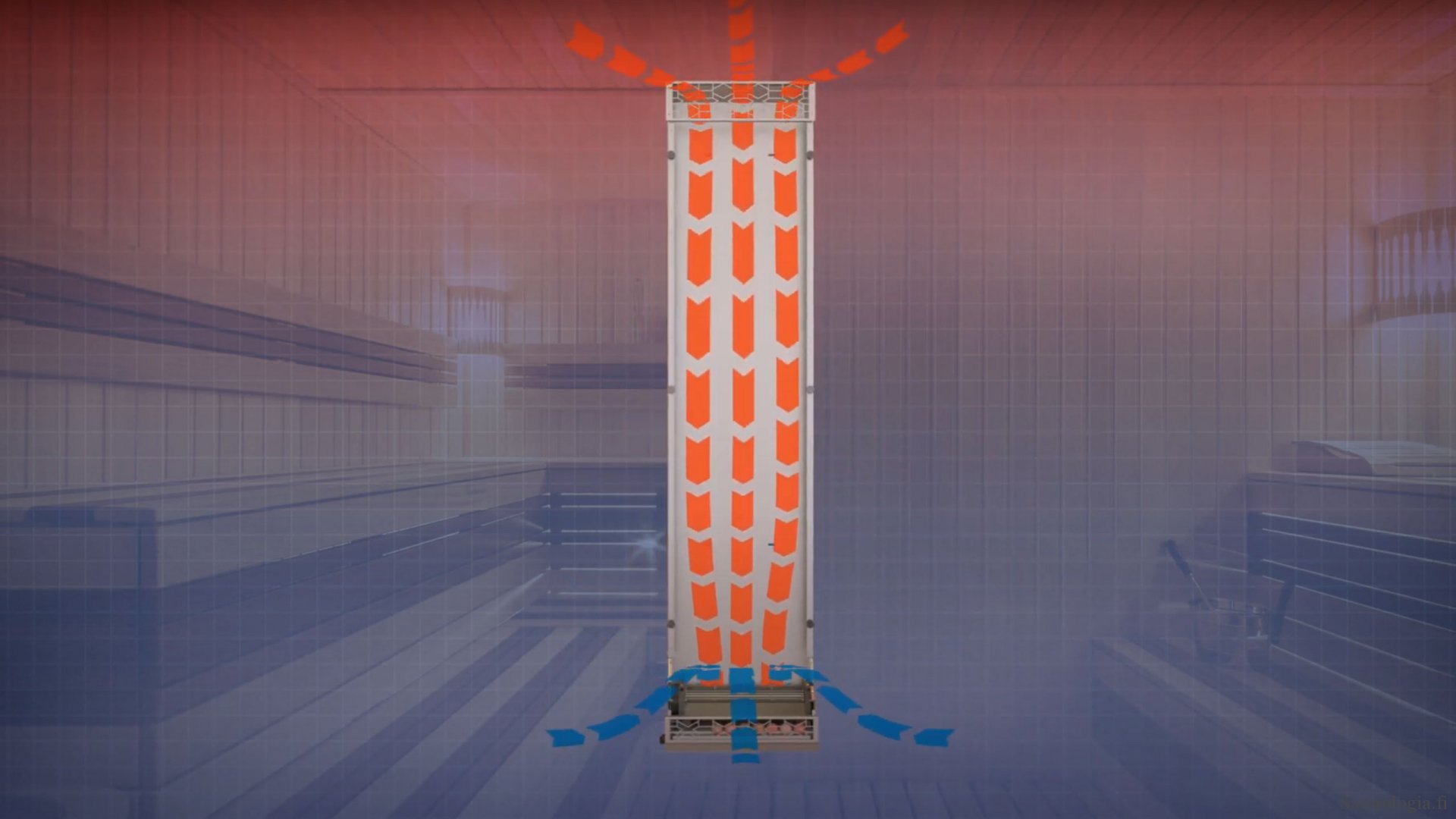
Visualisation of Saunum's operating principle from the manufacturer's video (C) Saunum, source YouTube
I have had several pleasant experiences with Saunum. Still, as opinions tend to vary in sauna matters, I wanted to test the usefulness of the heater from the perspective of a regular sauna user who was new to the concept. That is the background of this article, which also excited Saunum's Finnish dealer. We wanted to offer the heater for testing in a small electric sauna, where room height and volume restrictions often interfere with sauna performance. The project started in late September 2022, when I published an announcement about the opportunity on Saunologia. After a small lottery, the experiment began.
Experimental Environment
The experimenter of the heater turned out to be Erkka Suominen. He is a long-time sauna and ice hockey enthusiast, and entrepreneur living in Tapiola, Espoo. Combining sauna and sport has been integral to Erkka's lifestyle for decades.
"I like all kinds of saunas. An elevated sauna tent, army-style was one of the most memorable saunas from my student days. My dream sauna is an old wood-heated loft sauna," Erkka says.
These days, Erkka mostly enjoys saunas in modern environments. The sauna from the 2010s is located in Erkka's apartment above the Ainoa shopping center. The sauna is small, only 6.5 cubic meters (230 cu ft), low, and integrated through an expansive glass wall into the bathroom area. One bench, a rear wall bench for sitting, with room for just two hockey players without equipment. The sauna area has a reasonably arranged mechanical ventilation system.
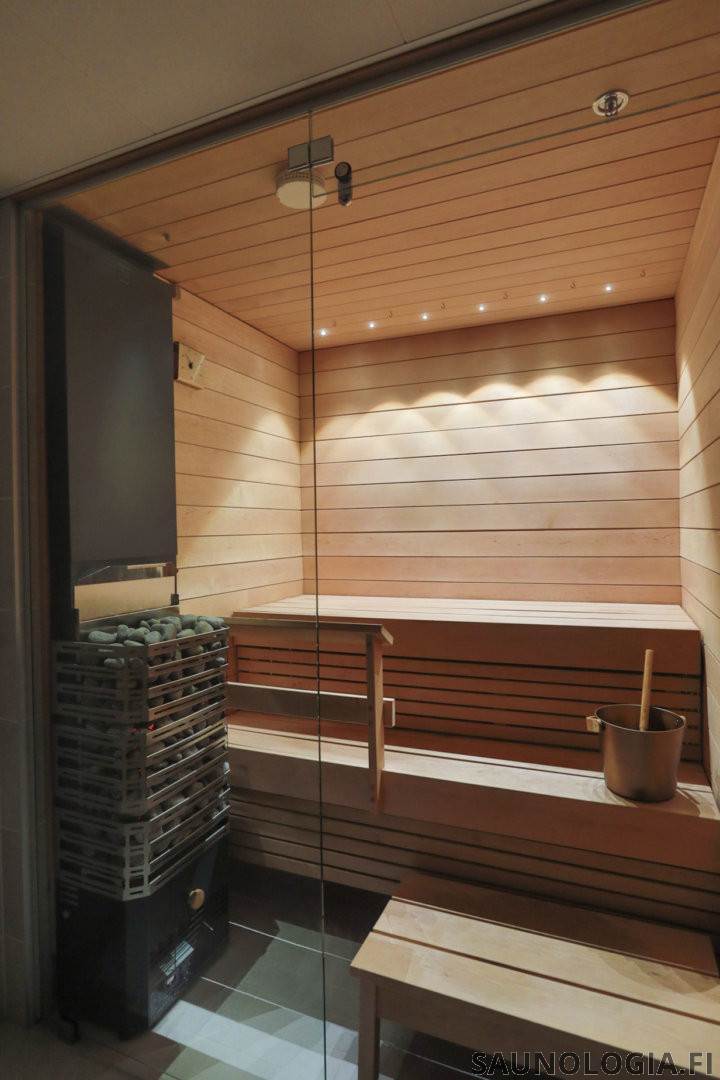
Just under three square meters of sauna in all its glory. The spaces are so tight in every direction that representative photography is difficult.
Before the Saunum, Erkka's sauna was heated by one of Finland's most popular electric sauna heaters, the Harvia Cilindro. The Cilindro has a solid 80 kg (180 lbs) of stones, but the heater is tall for such a low sauna. Erkka knew there was room for improvement and jumped at the opportunity offered by Saunologia to try a different setup. An anthracite-colored Saunum Primary 9 kW (aka Saunum Air) with an open stone basket and a new Leil Wifi (aka AirIQ with Wifi) control unit was selected. The heater was a good fit for the space, on paper slightly on the bigger end to compensate for the glass wall.
The experiment was carried out in November-December 2022, with the author consulting with Erkka before and after. Eventually we shared the sauna bench to experience in first hand the new sauna.
Experiences before and after the experiment
Before the experiment, Erkka found that the previous heater’s most significant drawback was the sauna's uneven heat distribution. To get a good, smoother sauna experience, one had to raise their feet to the upper platform. This was inconvenient for a big man in a small sauna in the long run, although the Löyly's soul installed on the stove provided some comfort. After a while, the sauna would often become oppressively hot, leading to an urgent need to move to the terrace for a cooldown. This issue frequently occurs in small saunas, where the heat peak is strongly concentrated on the head and upper body.
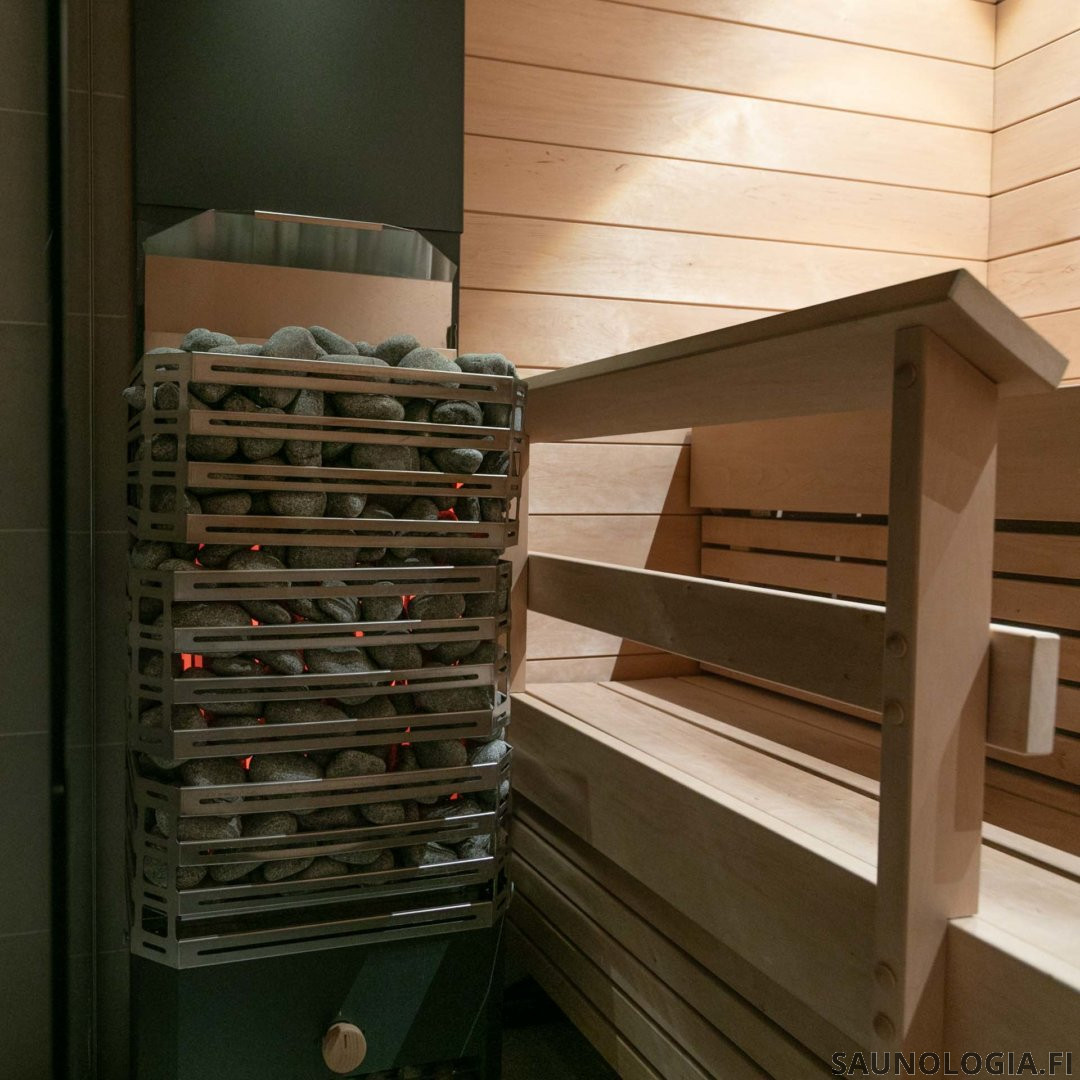
The Primary is a stove that stands on its legs and fits into a small space. Usually, a model with a closed stone space is recommended for such a tight space.
The old sauna heater was set aside, and that's where it stayed after the experiment. The experiment noticeably improved Erkka's sauna comfort. He was now able to spend longer time in the sauna than before. With the Saunum heater, he could create different sauna conditions if desired by changing the combination of the sauna room's target temperature and fan strength.
A month into the trial, Erkka preferred 80 ℃ (176 F) with fan power 2 or 70 ℃ with power 1. With these settings, he could experience very different sauna conditions.
A crucial feature of the Saunum heater is the mechanism that circulates the air and mixes the temperature layers above and below. When the sauna heats up without circulating air, everything remains as before, and the temperature differences in the sauna are significant due to the Saunum Primary's height. However, turning on the circulation clearly and measurably evens the temperature differences. Before, the temperature difference from the ceiling to the footboard was more than 30 C, but now it's below 15 C. The difference is tricky to translate perfectly to imperial units, but we’re talking approximately about 60 to 30 F change.
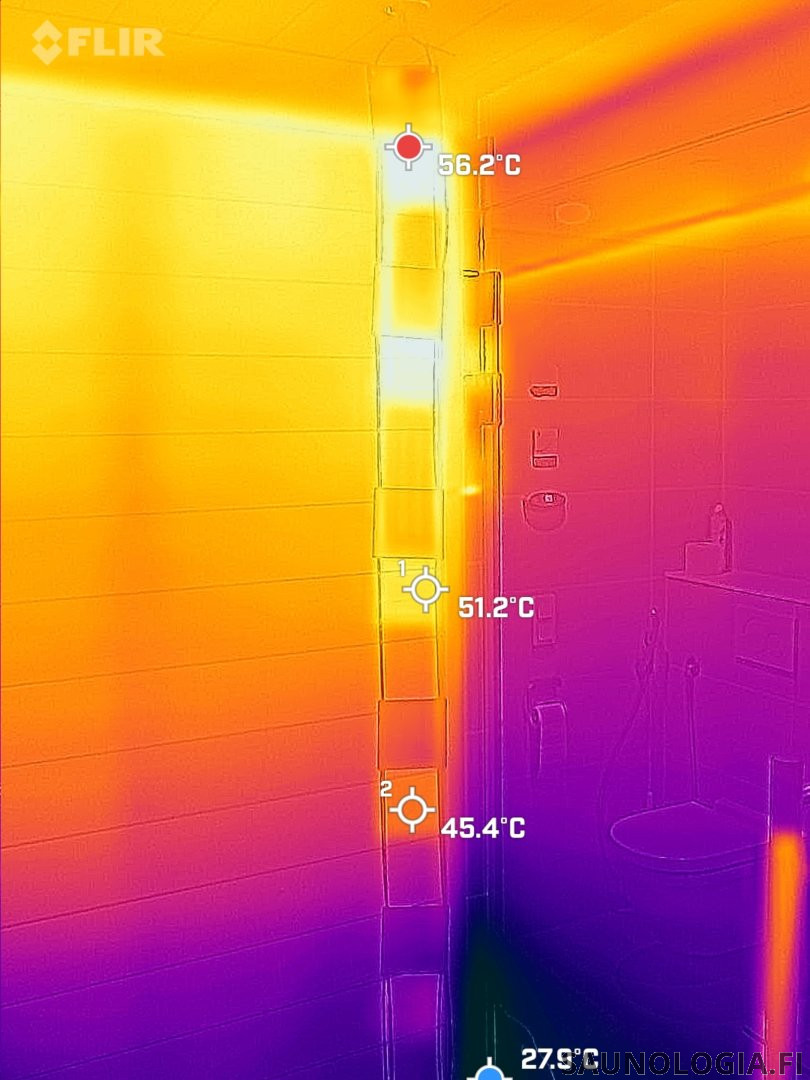
The temperature distribution in Erkka's sauna is visible in the thermal camera image. Due to an alignment problem, the comparison figures were not directly extracted from this image.
A visit to the benches confirms what the thermal camera shows. You no longer have to lift your feet to the top bench to warm your toes. Note that due to the alignment issue visible in the thermal camera image, the temperature values have been checked separately from the infrared image.
Saunum rocks, and is in heavy use
More than half a year after starting the experiment, Erkka says that "Saunum rocks, and is in heavy use." It appears to be the right heater for the right space and is there to stay. When photographing, the right side of the heater was still missing the ordered metal protective wall between the benches, which is a good safety tool with an open stone basket stove.
Saunum Leil (AirIQ) control panel
Erka's test equipment included Saunum's remote-controlled Leil control panel. Remote control proved to be practical for the busy man. When I interviewed him around Christmas, Erkka hadn't touched the physical panel in some time, instead opting to turn on the sauna from his smartphone. The Saunum Leil mobile application on the other hand, only gets a satisfactory rating, but Erkka believes that it will still be improved because, like the control panel software, both can be updated via the internet.
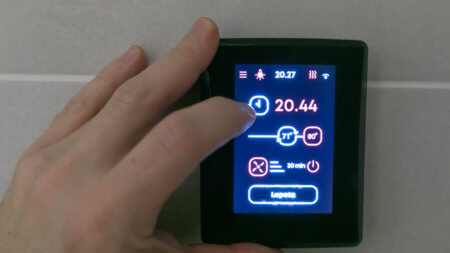
Saunum Leil Wifi (AirIQ) control panel
Benefits and disadvantages of air circulating heaters or forced air devices
The air circulation function in a sauna can help solve the following problems:
- Uneven heat distribution between the ceiling and the lowest benches
- Poor mixing of fresh air coming into the sauna with room air
- Accessibility of steam for people with mobility restrictions
- The heat exchange between the skin and the air is significantly more effective
These problems detract from the comfort of the sauna in different ways. They lead to a shortening of the sauna time and limit the use of the sauna. All of these problems are also difficult to fix the sauna is built. Contrary to what stove sellers assure, usually changing any conventional stove doesn't significantly affect the heat distribution. This problem is caused by the low ceiling and benches in the steam room in relation to the stove and is very common in Finnish saunas, primarily due to the trend of tall pillar stoves. The temperature distribution problem cannot be easily and reliably corrected by any other known method than forced air.
Although forced air technology gets a big thumbs up from sauna experts, Saunum's current implementation of forced air functionality also has certain limitations. These are:
- Blowing air creates noise
- The blower motor has only three pre-set intensities
- Directing the blow changes the conditions inside the sauna
- Heating the steam room more evenly requires more energy
The first two challenges are the state of current technology and likely to be eliminated in future versions. The third problem also arose in Erkka's sauna and is typical for all small spaces. Because the air blows from one place, it tends to focus more on one part of the sauna than another. In Erkka's sauna, it is part of the bench opposite the stove; in my own sauna, it's in front of the stove. The problem is not critical and Saunum has a solution to deflect the air in works, so this will be solved in the futurte . The fourth, energy-related, challenge is real and deserves more consideration.
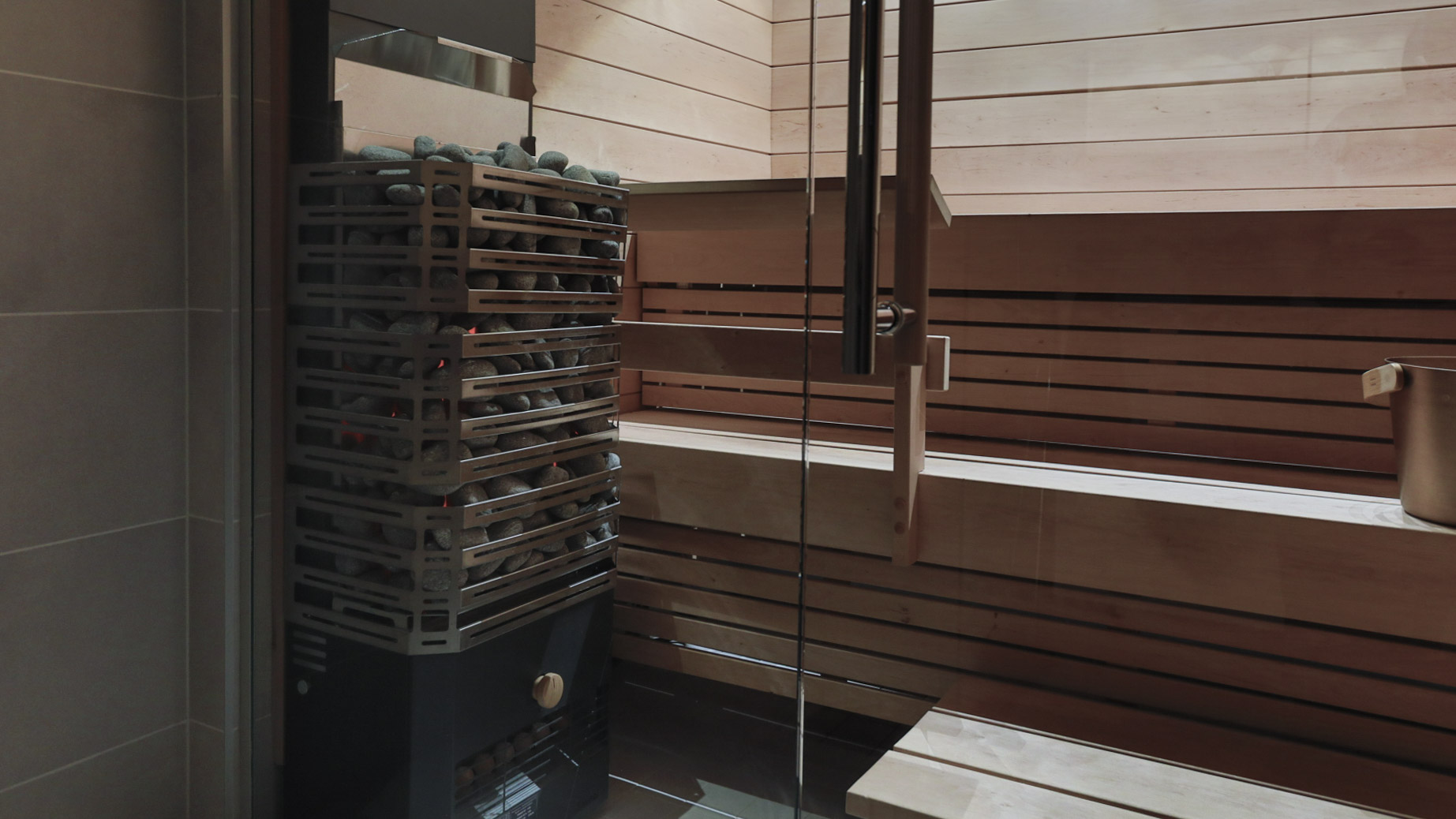
The larger the steam pocket, the greater the energy need
One fact revealed by the forced air stove is that thermal energy does distribute differently if you heat the sauna with forced air from floor level (about 20 cm; 8”) upwards. This means that the average temperature of the sauna air first drops when the forced air function is activated.
Suppose you want the same temperature in the sauna as you are used to in a regular sauna, for example, 80℃ (176 F). In that case, you need significantly more heat power with forced air, because there is more volume and more wall surfaces to be heated. If previously only about 50% of the sauna was adequately heated, over 80% of the volume is over 50% more. The user will notice that sauna no longer heats up as fast.They can correct the situation as follows:
- Preheat the sauna significantly hotter than intended, which stores more heat in the stones and surfaces
- Get an "overpowered stove" in advance
- Use a wood-burning stove instead of an electric stove for heating, which has more power reserve. This is, of course, only possible in a sauna with two stoves.
Enhanced preheating helps a bit, but the heat levels off quite quickly, and then the stove stays on throughout the sauna. Acquiring an overpowered stove is a double-edged sword. It can lead to the sauna "heating up" too quickly while the stones remain cold. In the case of Saunum, this could be compensated by keeping the forced air on even before the sauna "heats up", giving the stones time to warm up. The door cannot be kept open if the stove has a remote control and a door switch.
I myself have had the best experiences with the last trick. That is, I heat the wood-burning stove and use Saunum Primary as a forced air device. This is because my wood stove has a nominal power of 16 kW, which is even 78% more powerful than the electric stove!
In addition to the rise in total power need, an interesting observation is how relatively little energy is required for air circulation. The power of Saunum's blower motor is at full power only 60 W, while the sauna stove happily takes the full 9 kW. So the ratio is 1:150.
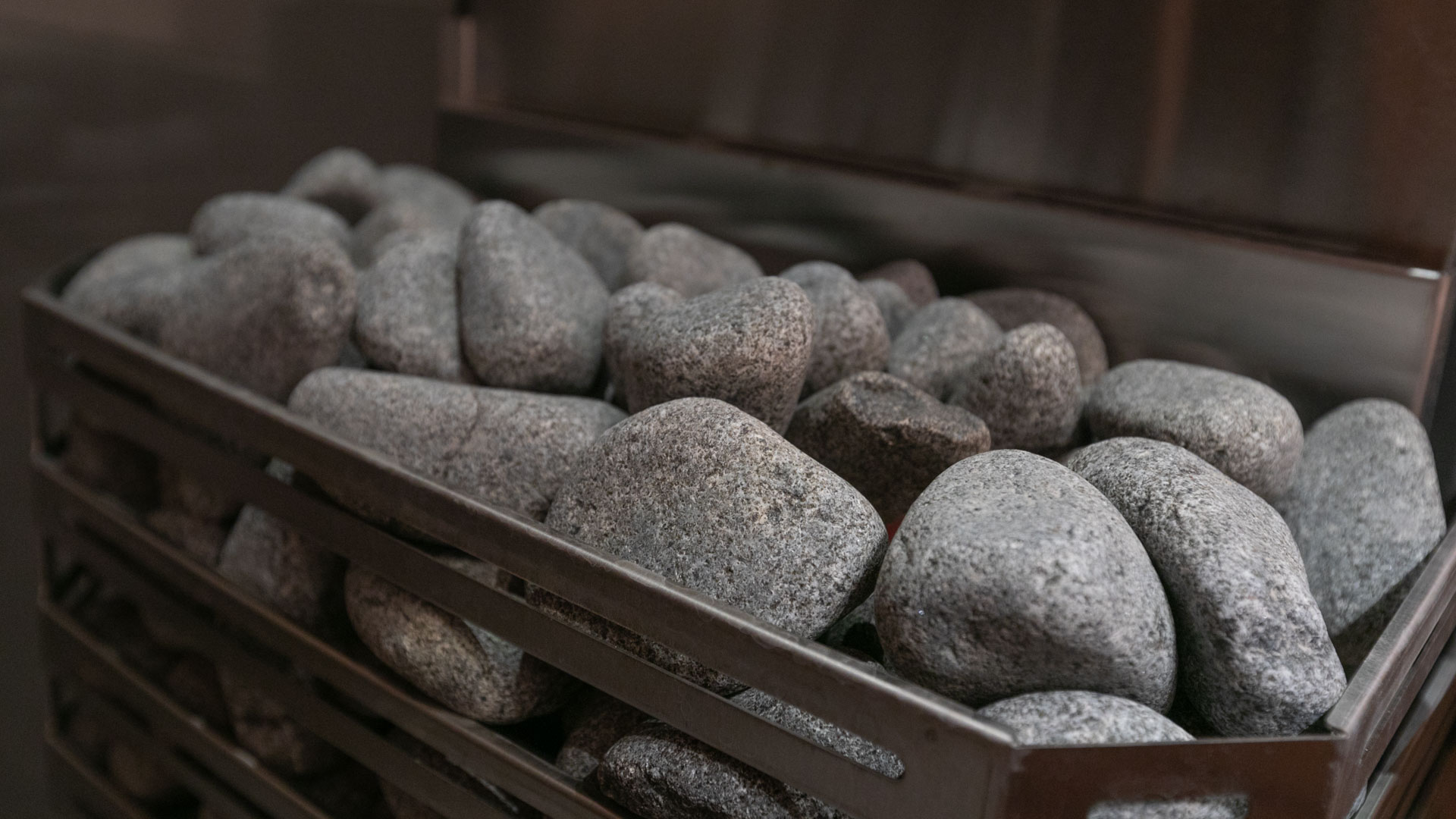
Summary: A Great Improvement to a Small Sauna
At Saunologia, we often approach various new sauna technology innovations with skepticism. However, I have enthusiastically tested different devices with varying results. Most often, they change the situation, but too little. Statistically speaking, the effect size remains too small.
In my opinion, Saunum's forced air devices and stoves are the most significant improvement solution that can easily be retrofitted to a sauna. For example, improving room ventilation is much more difficult or even impossible in many cases, like in Erkka's or my own sauna. The forced air device is the only effective remedy for these spaces, and if it comes with a heater, the total number of electrical appliances does not increase even though the electrical installation take their time and effort.
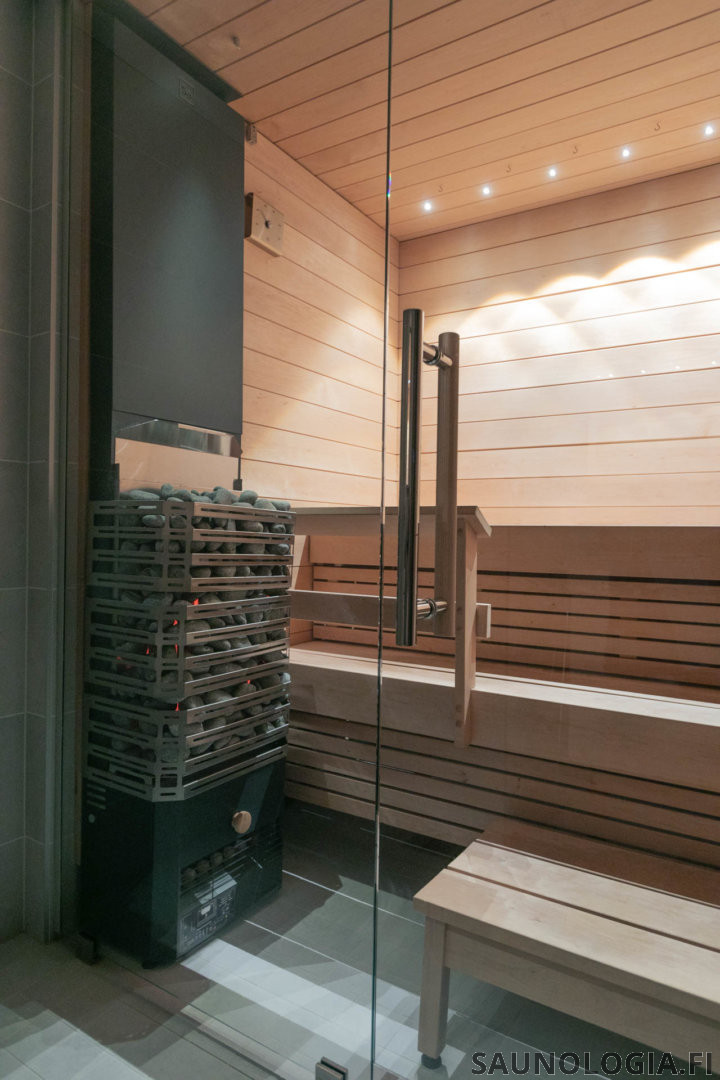
I have also recommended Saunum to some of Saunologia's clients. For instance, one reader from Kouvola, Finland had bought a nearly new detached house where the temperature distribution was badly off. They didn't want to retrofit the brand-new sauna, but by getting an air circulation stove for the space, the owner managed to save and improve the sauna experience in one stroke.
Saunum technology has very recently in 2023 received required UL certification for the American market and is now available across the States. At one US retailer, Sauna Marketplace, prices for Saunum's forced air devices start at $1,500 USD for the Air Solo device and $2,050 USD for Air heaters.
This article was created in commercial cooperation with the Saunum Finland and Saunum Group Oõ. Sauna Marketplace helped with the English translation of the original Finnish article..
Thanks to Erkka and Risto for collaborating on the implementation of the project!
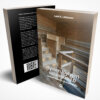

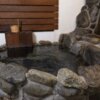

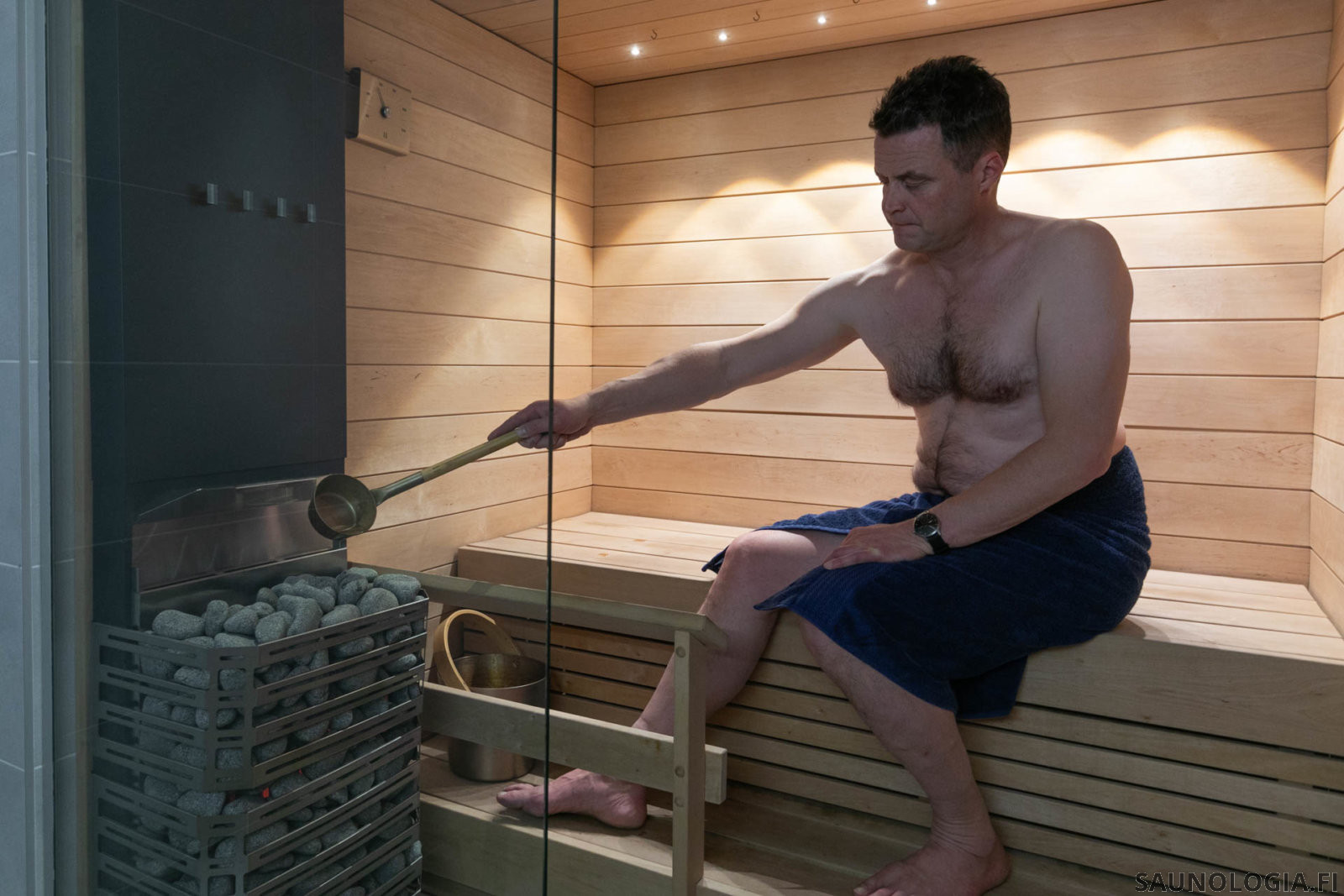
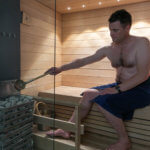
Lassi, thank you very much for this case study, could you please comment more in detail on the ventilation set up – I could not find it in the article? Is the fresh air intake placed in the ceiling – there can be seen something in the pic that could be it, about 50cm from the shorter wall? The mechanical downdraft is placed behind the low bench? Could it be that the increased stratification in the original set up was actually a combination of not ideally placed fresh air intake in the ceiling (the air did not heat up properly), the small size of the sauna and the high original cilindro heater? Maybe also with the combination of not properly air tight door? I would like to build a sauna of similar size (1.8x2x2.1m – w*d*h) and am wondering if reasonable stratification is actually achievable without a saunum product or it is a lost fight using ceiling fresh air intake and a regular (yet lower) open grate heater.
Hello,
In this case the supply was in the ceiling.
It is not uncommon to see similar saunas with wrong ventilation design and consequently bad stratification.
You can definitely get much better results if you stick to a low heater and a well designed and implemented mechanical ventilation.
Best
Lassi
Hi Lassi,
if read a lot of your content and I'm a litte lost in all guide lines. If your book covers all my questions, just tell me and I'll order it right away.
When designing a new 15,5 m3 sauna, 2,5-2,6m ceiling height (for sufficient bench height above the cold zone), electric heater, i found the following guidelines:
- heater power = cubic meters = aprox. 12-15kW
- stone mass: 10-16kg/m3 = 150-250kg
It's hard to find a heater capable of holding 150-250kg stones. To reach this mass I have to use commercial sizes or big mesh/tower style heaters. For example Narvi Peak Big (180kg, 18kW) or IKI Pillar (170/250kg, 12/15kW) or IKI Pro 14 (240kg, 13,8kW). Some of them are recommended for public saunas and also are very tall and I doubt if they fit my privat sauna.
Where would you suggest the sweet spot between enough stone mass, stone height and sufficient but not to much power?
And do all those guidelines still work if using a saunum heater (for example Pro Experience 12/15kW and "only" 105-120 kg stones)?
Greetings Tim
Dear Tim,
I am not sure if I have released an online article about heater fitting, but the topic is covered in my book. This article is not that anyhow
I really like this air circulating heater! It's a great way to improve the comfort of a small sauna.